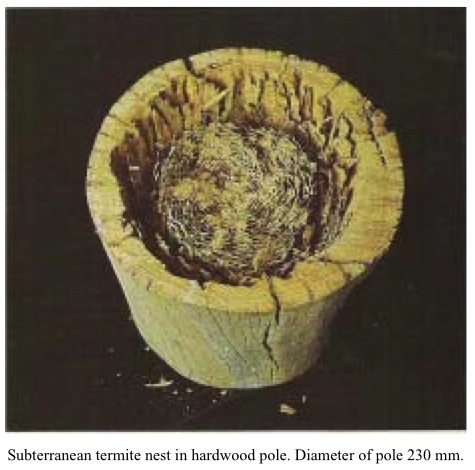PESTS AND DISEASES OF FORESTRY IN NEW ZEALAND
Australian Subterranean termites
Scion is the leading provider of forest-related knowledge in New Zealand
Formerly known as the Forest Research Institute, Scion has been a leader in research relating to forest health for over 50 years. The Rotorua-based Crown Research Institute continues to provide science that will protect all forests from damage caused by insect pests, pathogens and weeds. The information presented below arises from these research activities.
From Forest Health News 159, February 2006.
With the recent discovery of Australian subterranean termites (Coptotermes acinaciformis) in the South Island at Richmond, Nelson, perhaps it is timely to review the history of these insects in New Zealand because quite a bit of misinformation has been written about them. At this stage the infestation in Richmond is apparently confined to one property and all indications are that the termites arrived in New Zealand in Australian rail sleepers imported for landscaping purposes. The Ministry of Agriculture and Forestry is following this up. For further information see the scoop article "Termites found in Nelson".

Australian subterranean termites (Coptotermes acinaciformis and C. frenchi) were first reported in New Zealand in 1939 in Auckland. There were hundreds of discrete infestations, all associated with imported Australian hardwood utility poles and tram sleepers. The problem was so severe that in 1940 the Termite Act was passed by the Government. This Act and its associated regulations formed the basis of a “termite control campaign”. The Act was repealed in 1976 and subterranean termites were dealt with under the Forest Disease Control Regulations for many years.
They are now dealt with under the Biosecurity Act. It is also interesting to note that the discovery of these termites prompted the Government to set up a separate quarantine service for timber and other forest produce. This started off with inspections of imported Australian hardwood poles and sawn timber (primarily sleepers) but soon grew to include all timber products including casewood and dunnage. Section 69 of the Forests Act 1949 formed the legislative basis for doing this. The provisions of this Act were further extended by the passing of the Forest Produce Import and Export Regulations in 1956. Today the Biosecurity Act covers these activities.
Since the initial discoveries in Auckland, subterranean termites have been found at numerous localities in the North Island including Rawhiti (Northland), New Plymouth, Waipaoa (Poverty Bay), Whakatane, Te Puke, Whangamata, Hamilton, Matamata, Morrinsville, and Otorohanga. All of these sites have been treated in attempts at eradication and all the evidence is that eradication has been successful in all of them. Up until 1990 the eradication measures consisted of removal of the termite nest (which in all cases was in imported Australian hardwood timber), the injection of minute amounts of arsenic into active termite runways, and sometimes treatment of the soil with an insecticide. Since 1990 the Sentricon® bait station system has been used. This system is based on hexaflumuron which prevents the termites from moulting. See the Sentricon website for further details.
The important thing to note is that all Australian subterranean infestations in New Zealand have been associated with imported Australian hardwood material and there is no evidence that they have spread here by way of winged adults. Sometimes the termites have been discovered many years after the material has been imported. In Otorohanga the poles that were the source of the infestation were imported into the country in the 1950s. These days all Australian hardwood utility poles and sleepers are fumigated on arrival at the border.
Richmond is the only known active Australian subterranean termite site in New Zealand and is the first record of these insects in the South Island.
Further reading (for those who are interested):
Bain. J.; Jenkin, M.J. 1983: Kalotermes banksiae, Glyptotermes brevicornis, and other termites (Isoptera) in New Zealand. New Zealand Entomologist 7: 365–371. (PDF)
John Bain, Ensis
This information is intended for general interest only. It is not intended to be a substitute for specific specialist advice on any matter and should not be relied on for that purpose. Scion will not be liable for any direct, indirect, incidental, special, consequential or exemplary damages, loss of profits, or any other intangible losses that result from using the information provided on this site.
(Scion is the trading name of the New Zealand Forest Research Institute Limited.)

 Farm Forestry New Zealand
Farm Forestry New Zealand

